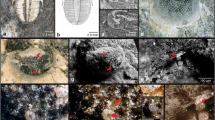Summary
The compound eye of Munida irrasa differs in several respects from the typical decapod eye. The proximal pigment is found only in retinula cells. The eccentric cell is extremely large and expanded to fill the interstices of the crystalline tract area; thus, a typical “clear-zone” is absent. Six retinula cells course distally to screen two sides of the crystalline cone. There are approximately 12,500 ommatidia in each compound eye.
There are several similarities to the typical decapod eye. Each ommatidium is composed of a typical cornea, corneagenous cells, crystalline cone cells, crystalline cone, crystalline cone tract and eight retinula cells. Distal pigment cells are present and surround the crystalline cone. The distal processes of the retinula cells also contain pigment. The retinula cell processes penetrate the basement membrane as fascicles composed of processes from adjacent retinulae.
Similar content being viewed by others
References
Barnes, R. D.: Invertebrate zoology, 3rd ed. Philadelphia: W. B. Saunders, Co. 1974
Bernards, H.: Der Bau des Komplexauges von Astacus fluviatilis. Z. wiss. Zool. 116, 649–707 (1916)
Berrill, M.: The aggressive behavior of Munida sars: (Crustacea: Galatheidae). Sarsia 43, 1–11 (1970)
Bullock, T. H., Horridge, G. A.: Structure and function in the nervous system of invertebrates. 2 vols. San Francisco: W. H. Freeman and Co. 1965
Eguchi, E., Waterman, T. H.: Fine structure patterns in crustacean rhabdomes. In: The functional organization of the compound eye (C. G. Barnard, ed.), p. 105–124. New York: Pergamon Press 1966
Ewen, A. B.: An improved aldehyde fuchsin staining technique for neurosecretory products in insects. Trans. Amer. micr. Soc. 81, 94–96 (1962)
Exner, S.: Die Physiologie der facettirten Augen von Krebsen und Insecten. Leipzig u. Wien: Franz Deuticke 1891
Gottlieb, F. J.: Connections between adjacent retinula cell columns in the eye of Ephestia kuehniella Zeller (Lepidoptera, Pyralididae). Cell Tiss. Res. 153, 189–193 (1974)
Gray, P.: The microtomists's formularly and guide. New York: The Blakiston Co. Inc. 1954
Hanström, B.: Untersuchungen über das Gehirn, insbesondere die Sehganglien der Crustaceen. Ark. Zool. 16, 1–119 (1924)
Hazlett, B. A.: The behavior of some deep water hermit crabs (Decapoda: Paguridae) from the Straits of Florida. Bull. mar. Sci. 16, 76–92 (1966)
Horridge, G. A.: Alternatives to superposition images in clear-zone compound eyes. Proc. roy. Soc. B 179, 97–124 (1971)
Kleinholz, L. H.: Pigment effectors. In: The physiology of Crustacea (T. H. Waterman, ed.), vol. 2, p. 133–169. New York: Acad. Press 1961
Kleinholz, L. H.: Hormonal regulation of retinal pigment migration in crustaceans. In: The functional organization of the compound eye (C. G. Bernhard, ed.), p. 89–101. New York: Pergammon Press 1966
Krebs, W.: The fine structure of the retinula of the compound eye of Astacus fluviatilis. Z. Zellforsch. 133, 399–414 (1972)
Kunze, P.: Comparative studies of arthropod superposition eyes. Z. vergl. Physiol. 76, 347–357 (1972)
Mowry, R. W.: The special value of methods that color both acid and vicinal hydroxyl groups in the histochemical study of mucins. With revised directions for the colloidal iron stain, the use of alcian blue G8X and their combinations with the periodic acid-Schiff reaction. Ann. N.Y. Acad. Sci. 106, 402–423 (1963)
Pantin, C. F. A.: Notes on microscopical technique for zoologists. London: Cambridge University Press 1964
Samuel, E. P.: Towards controllable silver staining. Anat. Rec. 166, 511–519 (1954)
Shaw, S. R.: Optics of arthropod compound eye. Science 164, 88–90 (1969)
Waterman, T. H.: Light sensitivity and vision. In: The physiology of Crustacea (T.H. Waterman, ed.), vol. 2, p. 1–64. New York: Acad. Press 1961
Williams, A. B.: Marine decapod crustaceans of the Carolinas. Fishery Bull. Fish. Wildl. Serv. U.S. 65, 1–298(1965)
Author information
Authors and Affiliations
Rights and permissions
About this article
Cite this article
Bursey, C.R. The microanatomy of the compound eye of Munida irrasa (Decapoda: Galatheidae). Cell Tissue Res. 160, 505–514 (1975). https://doi.org/10.1007/BF00225767
Received:
Issue Date:
DOI: https://doi.org/10.1007/BF00225767




